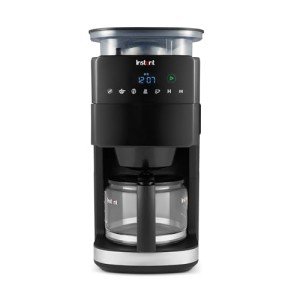16 Facebook Pages You Must Follow For Espresso Maker-Related Businesse…
페이지 정보

본문
The Ultimate Guide to Espresso Makers: From Beans to Brew
Espresso Machine With Milk Frother, typically explained as liquid art, is a cornerstone of coffee culture worldwide. The charm of a completely brewed shot of espresso is indisputable, evoking abundant flavors and stimulating scents that deal with enthusiasts and casual drinkers alike. For those looking for the Best Espresso Machine UK caffeine fix right in their cooking area, buying an espresso maker is a key very first action. This comprehensive guide will check out the various types of espresso makers, their functions, upkeep pointers, and an FAQ area to attend to typical questions.

Comprehending Espresso Makers
Espresso makers come in numerous designs, each catering to various skill levels, spending plans, and developing customs. Below is a relative analysis of the most popular categories.
| Type of Espresso Maker | Features | Pros | Cons |
|---|---|---|---|
| Manual Espresso Maker | Needs skill and precision; involves hand-pulling shots | Complete control over brewing procedure; portability | Steep finding out curve; lengthy |
| Semi-Automatic Espresso Machine | Uses a pump for pressure; user controls water circulation | Balance between control and convenience; excellent for home baristas | Needs some ability; can be expensive |
| Automatic Espresso Machine | Automates water flow and developing procedure | Easy to use; constant results | Restricted manual control; can be expensive |
| Super-Automatic Espresso Machine | One-touch operation; totally automated; integrated mills | Ultimate convenience; high personalization | High price point; can be intricate to tidy |
| Stovetop Espresso Maker (Moka Pot) | Simple, non-electric; brews coffee under steam and pressure | Inexpensive; suitable for stovetop brewing | Produces less pressure than electrical machines; might not accomplish true espresso |
| Pods/Capsule Machines | Pre-measured coffee pods; easy to utilize | Fast and hassle-free; minimal clean-up | Higher long-term cost; limited flavor options |
Key Features to Look for in an Espresso Maker
When picking an espresso maker, certain features may impact the general experience. Here are some important aspects to think about:
- Pump Pressure: Look for a machine that uses at least 9 bars of pressure to extract optimum tastes from the coffee beans.
- Temperature level Control: Consistent temperature level is essential for a great cup of espresso. Machines that control temperature level lead to better developing results.
- Build Quality: Choose models made from premium materials like stainless steel for sturdiness and aesthetic appeals.
- Ease of Use: Depending on your experience level, consider how instinctive the machine is to operate.
- Cleaning and Maintenance: Machines with easy-to-remove parts and descaling functions can conserve time.
- Grinder Availability: Some espresso makers include built-in grinders; this uses convenience and freshness.
Espresso-making Process
To brew the best espresso shot, follow these vital steps:
- Select Quality Beans: Freshly roasted beans are vital. Choose espresso or dark roast beans to achieve robust flavors.
- Grind: Use a burr grinder for a consistent grind size, aiming for a great texture for espresso.
- Step: Use a scale to determine out the advised amount of coffee, usually around 18-20 grams for a double shot.
- Tamp: Evenly disperse and tamp the ground coffee to form a flat, compact surface.
- Brew: Lock the portafilter into the machine, and begin the brewing procedure. Expect a rich, golden crema to form.
- Serve: Enjoy your espresso straight or use it as a base for other beverages like lattes and cappuccinos.
Upkeep Tips for Espresso Makers
To keep an espresso maker in ideal working condition, regular upkeep is essential. Here's a quick upkeep list:
- Daily Cleansing: Rinse the portafilter and basket right away after use.
- Weekly Cleaning: Clean the brew group and backflush with water or the suggested cleansing service.
- Descale: Descale the machine every three to 6 months, depending on water hardness.
- Examine Seals and Gaskets: Regularly inspect for any leakages or use and replace them as required.
Frequently asked question Section
1. Can I utilize routine coffee beans for espresso?
Yes, but it's suggested to utilize espresso beans, which are generally roasted longer for a richer flavor profile.
2. How do I understand if my espresso is over-extracted or under-extracted?
Over-extracted shots taste bitter and extreme, while under-extracted shots can taste sour and weak. Aim for a shot that balances sweet taste and acidity.
3. Is it essential to have a grinder with my espresso machine?
While you can buy pre-ground coffee, having a grinder enables for fresher coffee and better control over the grind size.
4. How long should I invest brewing an espresso?
A well-extracted Espresso Machine Under £500 shot typically takes about 25-30 seconds to brew.
5. What is the ideal water temperature level for developing espresso?
The ideal temperature level for brewing espresso is around 195 ° F to 205 ° F (90 ° C to
96 ° C). Picking an espresso maker is a financial investment in both devices and ability. By understanding the different types, functions, and techniques involved in developing your ideal shot, home baristas can elevate their coffee experience. Accept the artistry and science of espresso making, and cherish the delightful cups that follow.
Equipped with this details, anyone can start their espresso journey, enjoying the abundant, gratifying tastes that a well-brewed shot of espresso can supply. Whether it's with a manual machine or a super-automatic one, the love of espresso is universal-- one that can be explored socket by socket, cup by cup.

- 이전글7 Things You Never Knew About Drill Comparison 25.10.30
- 다음글9 Lessons Your Parents Taught You About Bunk Beds For Teens 25.10.30
댓글목록
등록된 댓글이 없습니다.
